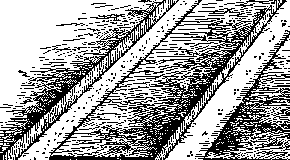Categories
Calendars
Guides
Reviews
Archive
Gallery
Articles
Ask Our Gardening Expert
How To Sow Lettuce(continued)
How to Sow Lettuce
Cover the seeds with soil, firming it down with gentle pressure. If the soil
is at all dry, water well. The seedlings should begin to appear in 7 to
14 days time. Gradually thin out the seedlings until they are 25cm (10in) apart. The sowing process is the same for all lettuce at all times of the year.
Where sowing in autumn for spring harvest, cloche protection will be required from October to January. Caring for Lettuce
Harvesting Lettuces With 'picking' lettuces, leave them in the ground, cutting the outer leaves
away from the plant near the base - new shoots will soon grow to replace
the harvested ones.
Use the table on the previous
page to determine when different types of lettuce can be sown. Note
that where some from of protection, like cloches or poly tunnel (basically just garden sized supported plastic), is
given to the seedlings, sowing can commence 4 weeks earlier than shown in the table.
Click here to view and buy from a large range of GardenAction approved poly-tunnels and cloches. Sow
every three weeks to ensure a continuous supply rather than a glut at
one time - lettuces do not keep well in the ground when they have
reached maturity. Use a trowel to dig out shallow drills 1.3cm (half inch) deep, each drill
being 30cm (1ft) apart from the next. Sow three or four seeds every 15cm
(6in) as shown in the right hand drill of the diagram. The seeds can be
sown in a continuous row (left hand drill of diagram), although this will require more seeds and more
thinning out later.
Sow
every three weeks to ensure a continuous supply rather than a glut at
one time - lettuces do not keep well in the ground when they have
reached maturity. Use a trowel to dig out shallow drills 1.3cm (half inch) deep, each drill
being 30cm (1ft) apart from the next. Sow three or four seeds every 15cm
(6in) as shown in the right hand drill of the diagram. The seeds can be
sown in a continuous row (left hand drill of diagram), although this will require more seeds and more
thinning out later.
 The
key requirements are water and weeding. Both can be greatly assisted by
laying a covering of organic material (or black plastic cut to allow the
seedlings through) around the plants, this will keep the soil moist and
stop the growth of weeds. It will also provide a slow but steady stream of nutrients.
The
key requirements are water and weeding. Both can be greatly assisted by
laying a covering of organic material (or black plastic cut to allow the
seedlings through) around the plants, this will keep the soil moist and
stop the growth of weeds. It will also provide a slow but steady stream of nutrients.
Harvest lettuces as soon as they mature, they will quickly
bolt
if left in the ground too long. When the heart of the lettuce begins to
form a point and grow upwards, it is beginning to bolt and should be
picked immediately. The easiest way to harvest them is to pull them out
with the roots using a trowel and trim with a sharp knife.
The pests are, lettuce root aphid (yellowing and decaying roots), lettuce root maggot (maggots present on the roots), greenfly and slugs. All of these can be treated using chemicals from your local garden centre. However, a few basic precautions should prevent them in the first place.
1.
Weed the bed - weeds provide a home for pests and diseases.
2. Remove harvested lettuces from the ground completely, do not
leave the stump in the ground. It will rot and attract the attention of
pests, root aphid in particular
3. Provide them with sufficient water especially in dry periods.
4. Water around the plants with
derris
(available from most garden
centres) in late May.
5. Do not grow lettuce in the same beds as has been previously
used for chrysanthemums. Doing so will increase the risk of root maggot.